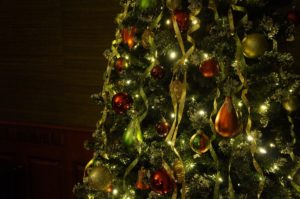
Help your Christmas tree thrive throughout the holiday season.
Growing up, it was a tradition in our family to cut and decorate the Christmas tree on the first day of December. While our beautiful Douglas firs would always look full and healthy for the first few weeks, the trees would start to dry up and lose their needles before Christmas arrived. On average, Christmas trees last about four weeks from the time they are cut. However, proper maintenance can help extend the life of your Christmas tree to keep it looking fresh all season long.
Choose the Right Location
When choosing a place in your home for a Christmas tree, consider factors other than just where it will look best. Where you set up your tree can have a direct impact on its life span. To prevent it from drying out prematurely, keep it away from direct sunlight, fireplaces, air vents, fans, and heaters. You may also want to have a humidifier nearby to help keep the needles fresh and reduce the risk of fire. Once you’ve found the perfect spot, place the tree immediately into a stand with a generous reservoir of water.
Follow a Watering Schedule
Not watering your live Christmas tree on a regular basis is one of the biggest mistakes you can make. A freshly cut tree will absorb up to a gallon of water daily, especially during the first week. During this period, it’s best to replenish the water once a day. The average Christmas tree stand will hold at least one gallon of water. For the remainder of the holiday season, check the water level daily and refill it as needed. Ideally, you want to keep the water level above the cut mark. Do not use additives in the water, including commercial tree preservatives or floral preservatives.
Recut the Tree Stem
Unless you cut the tree yourself and immediately place it into water, it has probably been sitting on the lot for several days. The vascular system that draws up water will likely have clogged, which prevents the tree from getting the moisture it needs. Before setting up your tree, cut approximately a quarter-inch off of the bottom of the trunk to open the vascular system up again. A simple straight-across cut will suffice. You do not need to cut at an angle or drill holes into the base of the trunk.
Start Preservation Early
Preservation of your tree begins the moment you step onto the Christmas tree lot. Before choosing a tree, give it a good shake. If a lot of needles fall out, move on to the next one. You want to choose a fresh, healthy tree with few to no brown needles. You may also want to choose varieties that are known to last longer, such as concolor firs, Fraser firs, Scotch pines, Douglas firs, and spruces. On the way home, help preserve the tree by wrapping it in netting or plastic. Leaving the tree unprotected in the wind can cause it to dry out faster.
